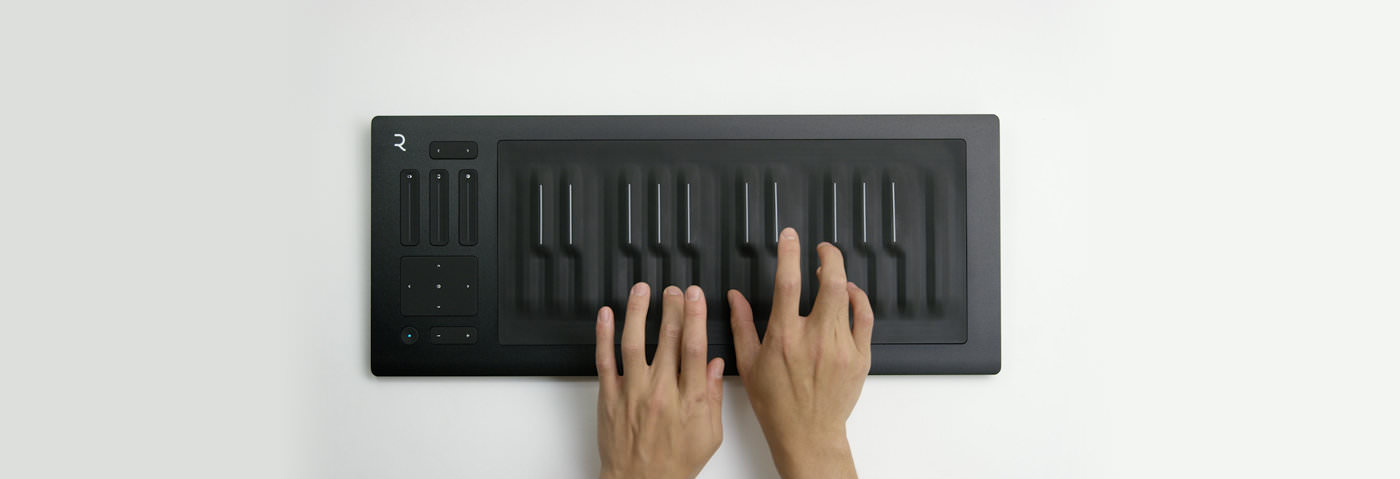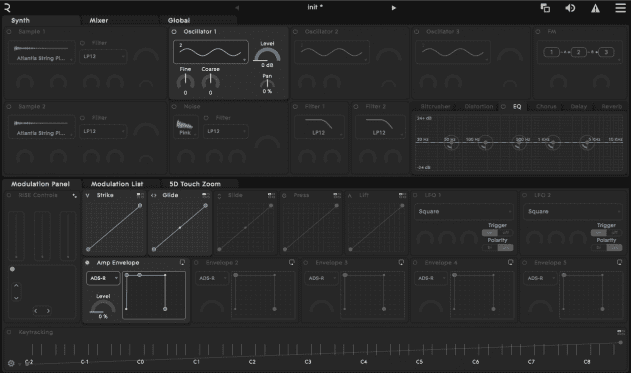Boundary-pushing London company ROLI specialise in innovative keyboard instruments. Greg Scarth finds out if their entry-level RISE controller lives up to the hype.
ROLI first appeared on our radar early in 2013 when they announced their flagship instrument, the Seaboard Grand. Initially available as a limited-edition run of 88 units (one for each note on the standard seven-and-a-bit-octave piano keyboard), the Grand is a unique expressive control surface with a built-in synth engine. It’s now available in its general release as an 88-, 61- or 37-key unit, while the new Seaboard RISE fills in the gap at the more affordable end of the market.
With a 25-key keyboard, the RISE is the most basic model in the Seaboard range, but it still feels like a top-quality piece of kit. It might be small and surprisingly thin (less than one inch wide across its entire length), but the unit as a whole is surprisingly heavy and clearly built to last. I couldn’t speculate as to the long-term durability of the silicone rubber playing surface, but the solid feel of the rest of the unit is certainly reassuring. The unit comes packaged in a basic foam storage case, with a supplementary Flip Case available as an optional extra, priced at £40 if bought with the RISE or £99 if bought separately.
It might be small and surprisingly thin, but the unit as a whole is surprisingly heavy and clearly built to last
Like the larger Seaboard units, MIDI is transmitted over USB. The RISE can also transmit MIDI over Bluetooth, and the unit has a built-in rechargeable battery for completely wireless operation, with no need to plug in to a power supply. Other than the playing surface itself, the features are simple, with just a small control panel section on the left-hand side of the keyboard, housing preset selection and octave shift buttons, touch faders to adjust the sensitivity of the expression parameters, an XY touch pad and the combined power button and mode indicator.
If you’re unfamiliar with ROLI’s technology, the rubberised keys on the RISE are, of course, the unique selling point of the hardware. ROLI refer to them as Keywaves because the way they flow into each other resembles waves or ripples on water (hence the name Seaboard). The Keywaves might look a lot like a regular keyboard covered in a thin layer of silicone rubber, but the feeling is completely different. The rubber itself is soft and pliable, allowing your fingers to slide smoothly around the keyboard. The physical feedback itself is maybe less pronounced than a traditional keyboard with a clear distinction between one key and the next, but that makes the Seaboard feel more like a continuous instrument than a set of discrete buttons. The strips along the top and bottom of the Keywaves also act like ribbon controllers, allowing you to play notes on a completely continuous chromatic scale.
In practice, just about any finger motion on the Keywaves is translated into some form of expressive feedback. ROLI describe this as 5D Touch, with the five dimensions being Strike, Press, Glide, Slide and Lift. Three of those are essentially close equivalents of standard MIDI keyboard functions; Strike, Press and Lift equate to velocity, aftertouch and release velocity, respectively. Even so, full polyphonic implementation of those control parameters is still relatively uncommon at any price point.
The Glide and Slide dimensions correspond to horizontal and vertical movement of a held note, and this is where the RISE really gets interesting. The closest analogy I can think of is a fretless string instrument like a violin, where any movement of the finger while sustaining a note results in a change in tone or pitch. The difference in this case is that there are multiple axes of expression available, with the limiting factor being defined by the mapping of the controls to your software instruments.
That question of software implementation leads us nicely onto one of the most important features of the Seaboard RISE. The keyboard comes bundled with Equator, ROLI’s own virtual instrument. If you judged it on its own, Equator might be seen as a capable if slightly unremarkable virtual instrument. It uses a mixture of samples and three oscillators as its sound sources, with a conventional subtractive architecture after that. Where it really shines – as you’d expect – is in the integration with the Seaboard’s 5D controls.
Equator is the perfect counterpart to the Seaboard. Running through its presets is the best way to get to grips with what the keyboard itself can do. You’ll find yourself intuitively using the expression gestures, first through modulating the pressure on the keywaves, and then by moving held notes around the surface. It’s worth pointing out that you certainly don’t need to be an accomplished keyboard player to benefit from the expressive capabilities of the Seaboard; even if you’re only just capable of holding down a chord or playing a one-finger bassline, you’ll still get a lot out of it.
Equator’s synth engine isn’t likely to win any awards for innovation, but that’s not really the point. It sounds good and shows off the potential of the hardware. Support for third-party synths is largely a custom job at this point; the ROLI Dashboard application is used to map the keyboard’s output to MIDI CC parameters, which can then be assigned to synth parameters.
Overall, the Seaboard RISE is a unique controller. Paired with Equator, it becomes a unique instrument. One of the biggest potential downsides of alternative controllers is that they can end up being almost too unusual for their own good. Controllers like the Haken Continuum or Roger Linn’s LinnStrument offer unique forms of expression, but they’re so far removed from traditional instruments that they can be daunting. The RISE plays it safe in comparison, working around a much more immediately recognisable keyboard paradigm. That’s not a criticism by any means; the result is that the Seaboard is a far more intuitive and accessible instrument to anyone familiar with a piano-style keyboard. Sit down at the RISE with Equator loaded and it’s almost impossible not to be charmed by its unique expressive capabilities. That can only be a good thing in terms of encouraging interesting results.
The Verdict
Price: £599
Purchase: Seaboard RISE
The Final Word
A pricy option as MIDI keyboards go, but the RISE is a unique proposition

